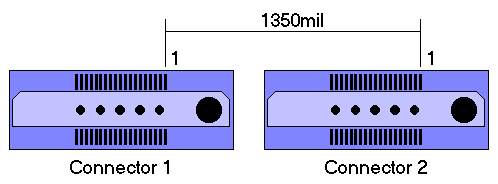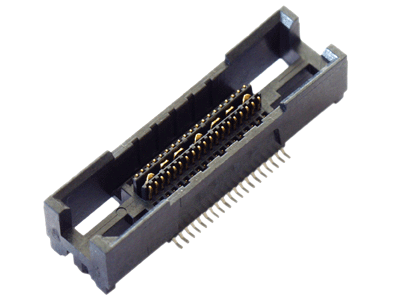Nexus Target Adaptation for DesignWare ARC Trace |
 
|
|||||

|
||||||
| ||||||
|
The adaptation applies for the following TRACE32 products:
| |||||||||||||||||||||||||||||||||||||||||||||||||||||||||||||||||||||||||||||||||||||||||||||||||||||||||||||||||||||||||||||||||||||||||||||||||||||||||||||||||||||||||||||||||||||||||||||||||||||||||||||||||||||||||||||||||||||||||||||||||||||||||||||||||||||||||||||||||||||||||||||||||||||||||||||||||||||||||||||||||||||||||||||||||||||||||||||||||||
| Tyco Part Number | Description |
|---|---|
| 2-5767004-2 | Vertical, surface mount, board to board/cable connector, RoHS compliant. |
| 767054-1 | Vertical, surface mount, board to board/cable connector. |
| 767061-1 | Vertical, surface mount, board to board/cable connector. |
| 5767044-1 | Right angle, straddle mount, board to board/cable connector, RoHS compliant. |
 Link to Tyco Electronics
Link to Tyco Electronics Target Connector Placement
Target Connector Placement

The adaptation uses one or two 38 pin Mictor connectors.
The second connector is only needed if the target trace port provides more than 16 trace data pins and for 8/16 bit demuxed mode.
A separation distance of 1350 mil is required if adaption without flex cable is intended.
We recommend to place the even numbered pins at the PCB border side (flex cable won't be twisted).
 Debug Signals
Debug Signals
The pinout of the Mictor connector optionally includes the debug signals which needs to go to the Debug Cable
(20-pin standard header). The Preprocessors have a 20-pin connector where the user can plug in the Debug Cable.
Alternatively the Debug Cable can be plugged on a separate 20-pin connector on the target. In this case there is no
need to connect the debug signals to the Mictor. For better signal quality it is better not to connect them.
The debug signals are TDI, TDO, TMS, TCK, RTCK, TRST-, EVTI, EVTO, SRST-, VREF-DEBUG.
(20-pin standard header). The Preprocessors have a 20-pin connector where the user can plug in the Debug Cable.
Alternatively the Debug Cable can be plugged on a separate 20-pin connector on the target. In this case there is no
need to connect the debug signals to the Mictor. For better signal quality it is better not to connect them.
The debug signals are TDI, TDO, TMS, TCK, RTCK, TRST-, EVTI, EVTO, SRST-, VREF-DEBUG.
| Pin | Direction | Description |
|---|---|---|
| TCK|TCKC | to CPU | JTAG Clock. It is recommended to put a pull-down to GND on this signal. |
| TMS | to CPU | Standard JTAG TMS: It is recommended to put a pull-up to VTREF on this signal for standard 4-pin JTAG. |
| TMSC | to/from CPU | Compact JTAG TMSC: Your chip should have a bus-hold on this line for compact JTAG. |
| TDI | to CPU | JTAG TDI. It is recommended to put a pull-up to VTREF on this signal. Only required for standard 4-pin JTAG / Optional signal for compact JTAG. |
| TDO | from CPU | JTAG TDO. (No pull-up or pull-down is required.) Only required for standard 4-pin JTAG / Optional signal for compact JTAG. |
| TRST- | to CPU | JTAG Testport Reset. (Optional, No pull-up or pull-down is required.) |
| RTCK | from CPU |
JTAG Return Clock. (Optional, No pull-up or pull-down is required.) |
| VREF-DEBUG | from CPU | Reference voltage. This voltage should indicate the nominal HIGH level for the JTAG pins. So for example, if your signals have a voltage swing from 0 V ... 3.3 V, the VREF-DEBUG pin should be connected to 3.3 V. |
| SRST- | to/from CPU | System Reset Signal. (Optional) If your target board has a low active CPU reset signal, you can connect this low active reset signal to this pin. This enables the debugger to detect a CPU reset. Furthermore the debugger can drive this pin to GND to hold the CPU in the reset state. The debugger drives this pin as open-drain, so a pull-up is mandatory. |
| EVTI | to CPU |
Nexus Event In (Optional) Transition to 1 forces a Nexus Synchronization Message |
| EVTO | from CPU |
Nexus Event Out. (optional) This pin is not used by ARC processors. |
 Trace Signals
Trace Signals
| Pin | Direction | Description |
|---|---|---|
| MKCO | from CPU | Nexus Message Clockout. (The trace clock.) This pin is mandatory and have to be on its dedicated position. |
| MSEOx | from CPU | Nexus Message Start/End Out. These signals controlling the transitions between the state in the Nexus state machine. The signals are mandatory. With TRACE32 command Analyzer.REMAP you can move them to the location of any MSEO or MDO pin. |
| MDOx | from CPU | Nexus Message Data Out. (Trace data signals.) Depending on the build configuration of the ARC trace block, you need 4, 8, or 16 MDO lines. With TRACE32 command Analyzer.REMAP you can move them to the location of any MSEO or MDO pin. |
| VREF-TRACE | from CPU | Reference voltage. This voltage should indicate the nominal HIGH level for the trace pins. So for example, if your signals have a voltage swing from 0 V ... 3.3 V, the VREF-TRACE pin should be connected to 3.3 V. This pin is mandatory and have to be on its dedicated position. |
Connector "TRACE A"
| Signal | Pin | Pin | Signal | ||
|---|---|---|---|---|---|
 | |||||
| N/C | 1 |  |  | 2 | N/C |
| N/C | 3 |  |  | 4 | N/C |
| N/C | 5 |  |  | 6 | MCKO |
| EVTI (opt.) | 7 |  |  | 8 | EVTO (opt.) |
| SRST- (opt.) | 9 |  |  | 10 | N/C |
| TDO | 11 |  |  | 12 | VREF-TRACE |
| RTCK (opt.) | 13 |  |  | 14 | VREF-JTAG |
| TCK | TCKC | 15 |  |  | 16 | MDO7 |
| TMS | TMSC | 17 |  |  | 18 | MDO6 |
| TDI | 19 |  |  | 20 | MDO5 |
| TRST- (opt.) | 21 |  |  | 22 | MDO4 |
| MDO15 | 23 |  |  | 24 | MDO3 |
| MDO14 | 25 |  |  | 26 | MDO2 |
| MDO13 | 27 |  |  | 28 | MDO1 |
| MDO12 | 29 |  |  | 30 | MDO0 |
| MDO11 | 31 |  |  | 32 | GND |
| MDO10 | 33 |  |  | 34 | GND |
| MDO9 | 35 |  |  | 36 | MSEO1 |
| MDO8 | 37 |  |  | 38 | MSEO0 |
 | |||||
| Connect Pin 39,40,41,42,43 to GND | |||||
VCC needs to have VREF-TRACE level.
Connector "TRACE B"
The second connector is not used.
Connector "TRACE A"
| Signal | Pin | Pin | Signal | ||
|---|---|---|---|---|---|
 | |||||
| N/C | 1 |  |  | 2 | N/C |
| N/C | 3 |  |  | 4 | N/C |
| N/C | 5 |  |  | 6 | MCKO |
| EVTI (opt.) | 7 |  |  | 8 | EVTO (opt.) |
| SRST- (opt.) | 9 |  |  | 10 | N/C |
| TDO | 11 |  |  | 12 | VREF-TRACE |
| RTCK (opt.) | 13 |  |  | 14 | VREF-JTAG |
| TCK | TCKC | 15 |  |  | 16 | MDO7_A |
| TMS | TMSC | 17 |  |  | 18 | MDO6_A |
| TDI | 19 |  |  | 20 | MDO5_A |
| TRST- (opt.) | 21 |  |  | 22 | MDO4_A |
| MDO7_B | 23 |  |  | 24 | MDO3_A |
| MDO6_B | 25 |  |  | 26 | MDO2_A |
| MDO5_B | 27 |  |  | 28 | MDO1_A |
| MDO4_B | 29 |  |  | 30 | MDO0_A |
| MDO3_B | 31 |  |  | 32 | MSEO1_B |
| MDO2_B | 33 |  |  | 34 | MSEO0_B |
| MDO1_B | 35 |  |  | 36 | MSEO1_A |
| MDO0_B | 37 |  |  | 38 | MSEO0_A |
 | |||||
| Connect Pin 39,40,41,42,43 to GND | |||||
VCC needs to have VREF-TRACE level.
Connector "TRACE B"
The second connector is not used.

|
Copyright © 2024 Lauterbach GmbH, Altlaufstr.40, 85635 Höhenkirchen-Siegertsbrunn, Germany
Impressum
Privacy Policy
The information presented is intended to give overview information only. Changes and technical enhancements or modifications can be made without notice. Report Errors Last generated/modified: 07-Mar-2024 |
 Target Connector
Target Connector

